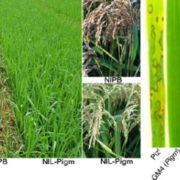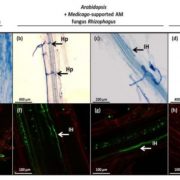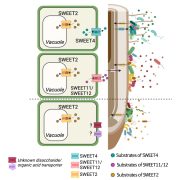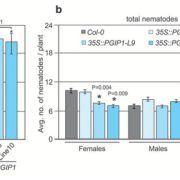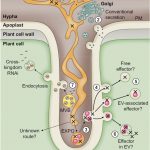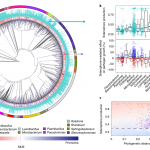Fungal antagonism of Arabidopsis oomycete infection requires a previously uncharacterized secreted hydrolase (bioRxiv)
 Antagonist interactions between microbes of the phyllosphere stabilize the microbiome and some “hub” organisms can exert strong effects on community structure. The yeast family Ustilaginales contains several apathogenic species that are microbial antagonists that can inhibit infection from diverse bacterial, fungal, and viral pathogens. This study by Eitzen et al. investigates the role of the epiphytic Ustilaginales yeast Moesziomyces albugensis as an antagonist of pathogenic oomycetes and the underlying mechanism of antagonism. Transcriptome analysis of M. albugensis identified nine candidate microbe-microbe effector genes; genetic deletions of candidate genes was used to assess their role as biocontrols against the oomycete Albugo laibachii. The M. albugensis Δg2490 line (g2490 encodes a secreted glycoside hydrolase “GH25”) almost completely lost its biocontrol activity against the oomycete, while genetically complemented lines restored antagonism. GH25 was previously uncharacterized and is transcriptionally activated specifically when both A. laibachii and M. albugensis are co-colonizing the surface of Arabidopsis. Further research into GH25 could help establish M. albugensis as a suitable biocontrol agent for crop protection. (Summary by Katy Dunning @plantmomkaty) bioRxiv
Antagonist interactions between microbes of the phyllosphere stabilize the microbiome and some “hub” organisms can exert strong effects on community structure. The yeast family Ustilaginales contains several apathogenic species that are microbial antagonists that can inhibit infection from diverse bacterial, fungal, and viral pathogens. This study by Eitzen et al. investigates the role of the epiphytic Ustilaginales yeast Moesziomyces albugensis as an antagonist of pathogenic oomycetes and the underlying mechanism of antagonism. Transcriptome analysis of M. albugensis identified nine candidate microbe-microbe effector genes; genetic deletions of candidate genes was used to assess their role as biocontrols against the oomycete Albugo laibachii. The M. albugensis Δg2490 line (g2490 encodes a secreted glycoside hydrolase “GH25”) almost completely lost its biocontrol activity against the oomycete, while genetically complemented lines restored antagonism. GH25 was previously uncharacterized and is transcriptionally activated specifically when both A. laibachii and M. albugensis are co-colonizing the surface of Arabidopsis. Further research into GH25 could help establish M. albugensis as a suitable biocontrol agent for crop protection. (Summary by Katy Dunning @plantmomkaty) bioRxiv


